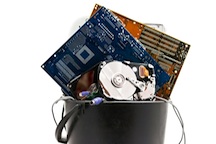
 We live in a toxic chemical stew. A wide variety of the objects that surround us in our indoor environments leach and outgas a cocktail of artificial chemicals that have been conclusively determined by medical science to be deleterious to human health. The typical “new car smell” motorists are so enamored of is composed of more than 50 toxic volatile organic compounds. A thorough clinical survey of the presence of the carcinogen p-DCB found that in the United States the number of people who had this chemical in their bodies was precisely 100%. Through exposure via inhalation, absorption and ingestion, we are constantly accumulating thousands of chemicals within our tissues that are rated as hazardous.
We live in a toxic chemical stew. A wide variety of the objects that surround us in our indoor environments leach and outgas a cocktail of artificial chemicals that have been conclusively determined by medical science to be deleterious to human health. The typical “new car smell” motorists are so enamored of is composed of more than 50 toxic volatile organic compounds. A thorough clinical survey of the presence of the carcinogen p-DCB found that in the United States the number of people who had this chemical in their bodies was precisely 100%. Through exposure via inhalation, absorption and ingestion, we are constantly accumulating thousands of chemicals within our tissues that are rated as hazardous.Computerized Devices Release BFRs and PVCs
The primary hazardous chemicals present within almost all computerized devices are brominated flame retardants (BFRs) and polyvinyl chloride (PVC). Various forms of BFRs are acknowledged toxins with a proven ability to accumulate within the human body. Not only can BFRs be released during the process of producing the electronics products themselves, but they also can be released during normal use. In today’s computerized world virtually all household dust contains some level of BFRs. If a computer device is disposed of through incineration, the BFRs are released in even more toxic forms, such as hydrogen bromide and brominated dioxins. PVCs are chlorinated plastics that integrate a group of chemicals called phthalates which have been linked to drastic changes in the reproductive systems of all mammals, including humans. The toxins in PVCs are released in much the same way as BFRs and can be just as dangerous.
Dizzying Rate of Electronics Obsolescence
The dizzying rate of obsolescence in electronics is creating mountains of products that were state of the art a few years ago but are nothing more than junk now. Most end of life electronics are shipped off to Third World countries where they are scavenged for the tiny amounts of precious metals, including gold, which they contain, and the rest burned off in the open air. The areas in China where massive electronic “recycling” is commonplace have become so toxic that the acidic river water will disintegrate a penny within a few hours.
Computer Case Fans Distribute Leached Chemicals into Your Air
You don’t have to eat your smartphone or toss it in your fireplace in order to release these toxic chemical substances in levels that can affect your health. Even common, everyday use can cause hazardous effects. The relatively low doses become chronic exposures over a long period of time. Many computer users have spent nearly half of their lives in the past couple of decades within a couple of feet from PC cases that are equipped with fans designed to cool the electronic components but also act to distribute the leached toxins into the immediate atmosphere.
Greenpeace regularly updates its Guide To Greener Electronics and the latest issue has found Nokia and Sony Ericsson leading the pack of major manufacturers on the toxic chemicals criteria, while on the opposite end, Toshiba, Microsoft, and Nintendo are noted for the worst showings. With the growing public outrage at this clear and present health danger, a popular movement has been gathering momentum to eliminate these toxins from our ecosystem. This vision of a chemical-free future is not restricted to electronics but is becoming all-encompassing. It even extends to the janitorial industry where recent technological developments allow devices that ionize plain tap water with a temporary electrical charge to clean surfaces as well as common cleaning solutions containing toxic brews of chemicals.
Progress towards the elimination of BFRs and PVCs in computer and smartphone electronics has been picking up speed and we can only hope that the day will come soon when we can purchase these devices in confidence that they are truly free from toxic chemicals.

![[外貿干貨] 想讓客戶回信?先別談產品,用這50句「看見他」的話打開局面](https://www.benchmarkemail.com/tw/wp-content/uploads/sites/8/2025/06/1.15配图2.webp)
